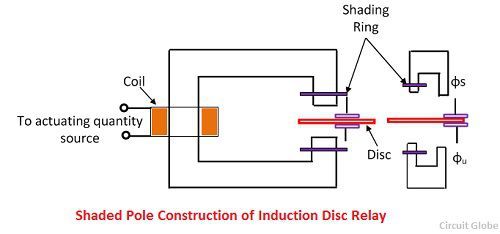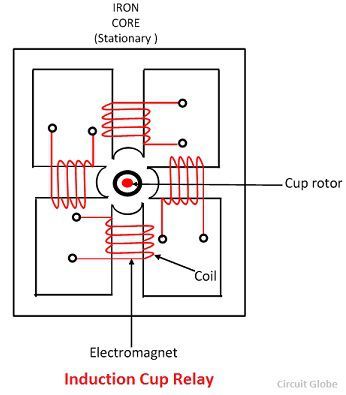Definition: Electromagnetic relays are those relay which operates on the principle of electromagnetic attraction. It is a type of a magnetic switch which uses the magnet for creating a magnetic field. The magnetic field then uses for opening and closing the switch and for performing the mechanical operation.
Types of an Electromagnetic Relay
By their working principle, the electromagnetic relay is mainly classified into two types. These are
- Electromagnetic Attraction Relay
- Electromagnetic Induction Relay
1. Electromagnetic Attraction Relay
In this relay, the armature is attracted to the pole of a magnet. The electromagnetic force exerted on the moving element is proportional to the square of the current flow through the coil. This relay responds to both the alternating and direct current.
For AC quantity the electromagnetic force developed is given as
 The above equation shows that the electromagnetic relay consists two components, one constant independent of time and another dependent upon time and pulsating at double supply frequency. This double supply frequency produces noise and hence damage the relay contacts.
The above equation shows that the electromagnetic relay consists two components, one constant independent of time and another dependent upon time and pulsating at double supply frequency. This double supply frequency produces noise and hence damage the relay contacts.
The difficulty of a double frequency supply is overcome by splitting the flux developing in the electromagnetic relay. These fluxes were acting simultaneously but differ in time phase. Thus the resulting deflecting force is always positive and constant. The splitting of fluxes is achieved by using the electromagnet having a phase shifting networks or by putting shading rings on the poles of an electromagnet.
The electromagnetic attraction relay is the simplest type of relay which includes a plunger (or solenoid), hinged armature, rotating armature (or balanced) and moving iron polarised relay. All these relays are shown below.
a. Balanced Beam Relay – In such type of relay two quantities are compared because the electromagnetic force developed varies as the square of the ampere-turn. The ratio of an operating current for such relay is low. If the relay is set for fast operation, then it will tend to overreach on a fast operation.
 b. Hinged armature relay – The sensitivity of the relay can be increased for DC operation by adding the permanent magnet. This relay is also known as the polarised moving relay.
b. Hinged armature relay – The sensitivity of the relay can be increased for DC operation by adding the permanent magnet. This relay is also known as the polarised moving relay.
 2. Electromagnetic Induction Relay
2. Electromagnetic Induction Relay
The electromagnetic relay operates on the principle of a split-phase induction motor. The initial force is developed on the moving element that may be disc or another form of the rotor of the non-magnetic moving element. The force is developed by the interaction of electromagnetic fluxes with eddy current, that is induced in the rotor by these fluxes.
The different type of structure has been used for obtaining the phase difference in the fluxes. These structures are
a. Shaded pole structure
b. Watt-hour meter or double winding structure
c. Induction cup structure.
a. Shaded pole structure
This coil is usually energised by current flowing in the single coil wound on a magnetic structure containing an air gap. The air-gap fluxes produce by the initializing current is split into two flux displace in time-space and by a shaded ring. The shaded ring is made up of the copper ring that encircles the part of the pole face of each pole.
 The disc is made up of aluminium. The inertia of the aluminium disc is very less.. Hence they need less deflecting torque for its movement. The two rings have the current induced in them by the alternating flux of the electromagnetic. The magnetic field develops from the current produces the flux in the portion of the iron ring surrounded by the ring to lag in phase by 40° to 50° behind the flux in the unshaded portion of the pole.
The disc is made up of aluminium. The inertia of the aluminium disc is very less.. Hence they need less deflecting torque for its movement. The two rings have the current induced in them by the alternating flux of the electromagnetic. The magnetic field develops from the current produces the flux in the portion of the iron ring surrounded by the ring to lag in phase by 40° to 50° behind the flux in the unshaded portion of the pole.
b. Watt-hour Meter Structure
This structure consists E shape electromagnet and a U shape electromagnet with a disc-free to rotate in between them. The phase displacement between the fluxes produced by the electromagnet is obtained by the flux generated by the two magnets having different resistance and inductance for the two circuits.
 The E-shaped electromagnet carries the two windings the primary and the secondary. The primary current was carrying the relay current I1 while the secondary winding is connected to the windings of the U-shaped electromagnet.
The E-shaped electromagnet carries the two windings the primary and the secondary. The primary current was carrying the relay current I1 while the secondary winding is connected to the windings of the U-shaped electromagnet.
The primary winding carries relay current I1 while the secondary current induces the emf in the secondary and so circulate the current I2 in it. The flux φ1 induces in the E shed magnet, and the flux φ induces in the U-shaped magnet. These fluxes induced in the upper and lower magnetic differs in phase by angle θ which will develop a driving torque on the disc proportional to φ1φ sinθ.
The most important feature of the relay is that opening can control their operation or close the secondary winding circuit. If the secondary winding is opened, then no torque will be developed, and thus relay can be made inoperative.
c. Induction Cup Relay
The relay which works on the principle of electromagnetic induction is known as the induction cup relay. The relay has two or more electromagnet which is energized by the relay coil. The static iron core is placed between the electromagnet as shown in the figure below.
 The coil which is wound on the electromagnet generates the rotating magnetic field. Because of the rotating magnetic field, the current induces inside the cup. Thus, the cup starts rotating. The direction of rotation of the cup is same as that of the current.
The coil which is wound on the electromagnet generates the rotating magnetic field. Because of the rotating magnetic field, the current induces inside the cup. Thus, the cup starts rotating. The direction of rotation of the cup is same as that of the current.
The more torque is produced in the induction cup relay as compared to the shaded and watt meter type relay. The relay is fast in operation and their operating time is very less approximately 0.01 sec.

What is AC,BC,CC in relay??